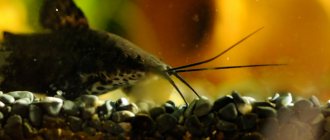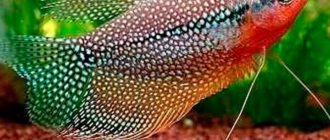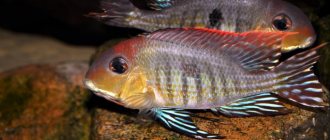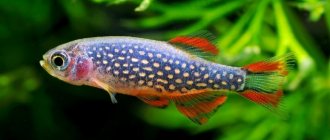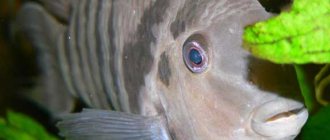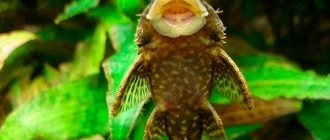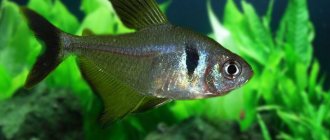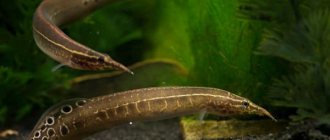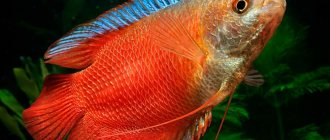What kind of aquarium fish is this?
Danio roseus, its second name is pink danio, received for the pinkish tint of the body. Belongs to the genus of ray-finned fish from the carp family . This species appeared in the aquarium hobby relatively recently, but has already become popular among both beginners and experienced aquarists.
The natural habitat is vast: from the countries of Indochina to India, and pink danios were first discovered in the Mekong River basin in Thailand. Later, the fish were spotted in the reservoirs of Myanmar and Northern Laos.
These places have an ideal natural biotype for this species: cool, oxygenated water. Pink danios settle near rapids and waterfalls with rocky soil and a small amount of flora; they are very fond of overgrown areas with dim lighting. They are tolerant of seasonal changes in reservoirs (changes of seasons, temperature changes).
Description of appearance
The body of pink danios is similar to a spindle: it is elongated and slightly flattened on the sides. The upper jaw is decorated with a pair of tiny antennae.
The abdomen of adult individuals is painted in a shiny pink color (in males the shade is more saturated, closer to red), the body is soft pink with a bluish tint, and the back half is blue.
Juveniles are grayish or pale blue in color. The color of the fins varies from yellow-orange to yellow-green. A purple-pink stripe runs along the anal fin.
How to distinguish a female from a male?
REFERENCE! Young zebrafish are very similar to each other, so sex determination is best done in adults.
A male can be distinguished from a female by the following characteristics:
- Dimensions. Females, which according to the laws of nature must bear eggs, have a larger and rounder abdomen. Their anal fin is longer and neater in appearance.
- Color. Males can boast of a striking color: their stripes are brighter, and the intensity of the tint of their scales is more intense. There is a reason for this - the more attractive a male is, the more females will pay attention to him. But the modest color of the female will protect her during the spawning period and allow her to hide in muddy water and algae thickets.
- Behavior. Males are more active than females. During mating games, it is the males who poke around the females, cutting circle after circle around her. And only the female can lay eggs.
How is it different from other zebrafish?
There are two types of pink zebrafish: real (lat. Brachydanio albolineatus), living in the wild, and a breeding form of zebrafish (lat. Danio rerio). The work of the breeders was received favorably by the public, and the resulting species is largely identical to the original, with the exception of two points. Firstly, Danio rerio has a brighter appearance due to the rich shade of its scales, and secondly, it is more prone to diseases and is smaller in size.
How long does it live?
The average lifespan of fish is 5-7 years. Lifespan is affected by:
- Habitat;
- Water temperature (the cooler it is, the longer zebrafish live);
- Aquarium dimensions;
- The amount of nitrogen compounds in the container.
Types of thorns
Caramels of various colors are obtained by injection with a coloring solution. External intervention allows you to achieve bizarre results, which are of interest not only to amateurs, but also to professionals.
Ternetia veil
Chemical exposure weakens the thornets' body, but does not change their biological characteristics, behavioral characteristics, or care for them. The main popular colors of fish:
- pink;
- blue;
- yellow;
- violet;
- green.
Fashion trends in the aquarium hobby are leading to the widespread proliferation of exotic caramels. Schooling fish are bought by at least 7-9 individuals, but the more there are in the group, the better. They occupy a worthy place among other types of thorns:
- classical;
- veil;
- gold;
- albinos.
Ternetia Glofish (GloFish) are modified fish with a fluorescent glow. Ultraviolet lighting makes them even brighter. Unlike caramels, color is inherited.
Ternetia multicolor
Thorn species are created by transgenic technologies using DNA from jellyfish, red corals, and various combinations. The result is forms of green, red, orange, blue, yellow flowers.
Interestingly, the dyeing does not extend the results to the tail or fins. They still remain black or dark green. This feature influenced the second name of the ternation - mourning tetra, since the long fin frames the bottom line of the body, creating a dark outline.
Photo
The following photo shows a pink zebrafish in an aquarium:
The price of thorns
Ternetias are widespread and can be found in any pet supply store or purchased online. Buying caramels is more expensive than buying ordinary thorns, ranging from 100-130 rubles.
The price depends on color preferences, order volume, age and condition of the fish. Pink thornia is very popular . Bright caramel delights lovers and delights children with its appearance.
No matter how much you have to pay for live fish, the real price is measured not by banknotes, but by genuine interest in the unusual world of the inhabitants of foreign rivers. It is human nature to conduct experiments and transform the world— the thorns in the photo are proof of this. The purchase of fish obliges the aquarist to treat the small and fragile life of caramels with care and attention.
Care and maintenance
Fish can exist in almost any water conditions, but basic hygiene must be observed. Both gravel and river sand, pre-washed in boiling water or calcined in the oven, are suitable for bottom soil.
As green spaces, you can purchase algae Heleocharis, Vallisneria or Sagittaria. Fish need lighting of at least 10-12 hours a day , so an additional light source is required.
- The optimal level of hardness is 5-15, acidity is 6.0-6.8.
- The suitable temperature range is from 15 to 28 degrees, during the spawning period and for the growth of fry - 19-26.
- Danios are extremely unpretentious and can live even in a three-liter jar, but a 20-40 liter tank for 6-8 fish will be more convenient. If you plan to move in, the volume should be increased to 50-80 liters. Choose an oblong aquarium with a tight lid.
- Once a week, be sure to change the water - 20% of the total volume. It is worth purchasing an aerator and filter for the aquarium. In principle, pink zebrafish can do without artificial aeration, but the use of these devices will only have a beneficial effect.
Difference by gender
Males and females have almost the same coloration. However, it is still possible to distinguish them, but only at a more mature age.
Females are almost always slightly larger and slower than males. Their coloring is more faded and subdued.
Males, on the contrary, have a slender and bright body with expressive stripes or spots on it.
By the way, it is very easy to determine the sex of the fish during the mating season: the more nimble and active male draws circles around the chosen lady.
Feeding
Zebrafish have an unpretentious taste, although they love live food and quickly gain weight on it. It is necessary to alternate dry granulated (Malawi, Tetra Phyll) and natural food (bloodworm, brine shrimp, tubuli). The grains of food should be very small so that it is easy for the fish to swallow it.
The feed rate is determined as follows: for 5 fish, it is enough to throw food on the tip of a knife 2-3 times a day and observe. If the food was eaten within 10 minutes, the portion was selected correctly, otherwise it is reduced.
It is better to give your fish less food than to overfeed them. With regular overfeeding, the fish begin to get fat and die. In case of excess food, do not feed for a while and partially change the water.
Reproduction
To avoid infection of eggs with a fungus, the water in the finished spawning area should be disinfected. You can put a silver object there, or add iodine to the water (3 drops per 10 liters).
REFERENCE! If a fluffy white coating appears on the surface of the caviar, it is infected with the byssus fungus. Such eggs are carefully pulled out of the aquarium with tweezers and destroyed.
Spawning
No special conditions required. A wide aquarium with a volume of at least 20 liters is prepared for the spawning area. A layer of soil (3 cm) is poured onto the bottom.
You can also stretch a fine mesh, but there should be no gaps between the walls of the container and the mesh, otherwise the fish will eat their offspring. Water is poured inside (to a level of 10-15 cm) and left for several days. It would not be superfluous to provide the spawning area with a heater.
The selected pair is seated in different aquariums and fed with live food (daphnia, bloodworms, and tubifex are suitable).
Fish prepared for spawning are transplanted into the spawning area and the lights are turned off. This is done in the evening, the water temperature should be at least 26 degrees. Spawning usually begins in the morning. The male chases the pregnant female, trying to hit her in the abdomen and help her free herself, while she spawns into the water column. An individual lays more than 200 eggs in an hour. At the end of the process, the fish are removed from the aquarium.
Caring for fry
The larvae begin to hatch after two days, but if the water temperature drops to 17 degrees, the process extends for a week, or even more. The larvae feed from the yolk sac for 5-6 days, then its reserves run out and they begin to move in search of food.
In the first week, babies are fed liquid food from a pet store or boiled egg yolk , after 7 days they can be given live dust, and after another week - cyclops or brine shrimp, beef heart.
If the fry differ noticeably in size, they should be placed in different containers. As it rises, the water temperature decreases.
Diseases
Danios are resistant to diseases, but if you do not follow the basics of care (lack of aeration of the aquarium, excess food, introducing undisinfected objects into the container), they will have all sorts of problems.
- Alkalosis . Dull skin, bloating, excessive mucus production, spreading fins, jumping out of the water and agitated behavior indicate that the pH of the aquarium water is significantly higher. A pH buffer and timely water changes help to avoid this.
Tuberculosis (mycobacteriosis) .
An infectious disease transmitted through algae, soil or sick fish. If the owner notices that the pet has noticeably lost weight, is lethargic and refuses food, and its scales have faded, the fish should be removed and supplemented with food (live or frozen bloodworms) with rifampicin or kanamycin.If an individual does not want to eat, the medicine is added to the water, but this is an extreme case, since antibiotics destroy nitrifying bacteria in the soil and cause a biological failure. The course of treatment is 2 weeks, the proportions are 3 g of kanamycin or 600 mg of rifampicin per 100 l. The disease can only be treated at an early stage.
IMPORTANT! General disinfection of the aquarium with all its components is mandatory!
- Trichodinosis. The causative agent of this disease attaches to the skin and gills of the fish, causing destruction of the fins, stunting and general exhaustion. Infected zebrafish become covered with a grayish coating, do not move away from the aeration bubbles, and rub against hard objects in the aquarium. Therapeutic baths with trypaflavin or table salt, which can be carried out in a common aquarium, help get rid of this infection.
- Exophthalmia (bulging eyes) . The reason is the accumulation of fluid in the eye area. Caused by a bacterial or viral infection, fungus, lack of vitamins or a violation of physiological processes. Treatment consists of partial water changes every 2-3 days.
- Growths. Rarely occur. Infected fish should be placed in a separate container with salted warm water for 15 minutes (2 tablespoons per liter of water).
- Poisoning. In this case, the fish begins to swim exclusively in a circle. The cause is most likely nitrate poisoning. The water will need to be replaced with another and then every 3 days, 1/3 of the container should be drained and filled with clean water.
- A sharp increase in the abdomen. Quite a common occurrence in this species. The fish stops contacting the rest of the school, lies on the bottom almost all the time, and its belly visibly swells. Metronidazole is used for treatment (a tablet dissolves in a liter of water), and after about 7-9 days the disease goes away.
Similar fish
If you are new to aquarium keeping, you can get fish that resemble pink danios in many ways. For example:
- Guppies (bright and beautiful fish that are easy to breed and raise. They are omnivorous, nimble, easy-going and unpretentious).
- Swordtails (active fish, tolerant of the owner’s mistakes).
- Cardinals (tiny, but extremely resilient and good-natured species).
- Corydoras (schooling catfish of variegated color, mobile, small in size).
- Wedge-spotted Rasboras (popular little ones with an extremely peaceful disposition).
Compatibility
Danios are schooling fish and are completely non-aggressive towards other inhabitants of the aquarium.
A flock of 7-10 fish, quickly cutting through the water space, does not harm anyone.
Active pink-pearl individuals coexist quite peacefully with such ornamental fish as
- swordtails,
- gourami of all types,
- loaches,
- mollies and others.
